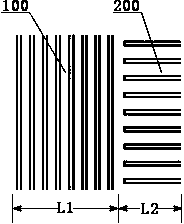Non-linear Cerenkov radiation light source based on doped optical superlattice
An optical superlattice, nonlinear technology, applied in the field of lasers, can solve problems such as unreported, and achieve the effect of improving integration and wide application
- Summary
- Abstract
- Description
- Claims
- Application Information
AI Technical Summary
Problems solved by technology
Method used
Image
Examples
Embodiment 1
[0023] Such as figure 1 As shown, a nonlinear Cerenkov radiation source based on doped optical superlattice, including: laser pump source 1, input plane mirror M1, doped optical superlattice crystal 3, Q switch 4, polarizing lens 5 flat concave mirror M2. The input plane mirror M1 and the plano-concave mirror M2 together with the housing form an optical resonant cavity. The optical resonant cavity is a two-mirror cavity composed of a plane mirror and a flat-concave mirror. The coating of the input plane mirror M1 is highly transparent to the pump light and highly reflective to the fundamental wave light, and the coating of the plano-concave mirror M2 is highly reflective to the fundamental wave light. Doped optical superlattice crystal 3, Q switch 4 and polarizing lens 5 are located in the optical resonant cavity. Wherein, the Q switch 4 is located between the doped optical superlattice crystal 3 and the polarizing lens 5; the optical superlattice crystal 3 is located betwe...
Embodiment 2
[0027] In the structure of the foregoing embodiment 1, the laser pumping source 1 is a laser diode with an operating wavelength of 980 nm. The doped optical superlattice crystal 3 is lithium niobate or lithium tantalate optical superlattice crystal doped with 1% mole fraction of ytterbium (Yb). The wavelength of light emitted by ytterbium (Yb) ions is about 1060nm (different matrix materials correspond to slightly different laser emission wavelengths), that is, the fundamental wavelength of light is about 1060nm. The doped optical superlattice crystal 3 is placed in a direction in which the direction of the domain wall is parallel to the direction of the optical axis of the optical resonant cavity. The length of the light transmission direction of the doped optical superlattice crystal 3 is 1mm, and the two end faces are coated with a high-transmittance film for the fundamental wave light of 1060nm and the pump light of 980nm. The film system on the input plane mirror M1 is h...
Embodiment 3
[0029] In the structure of the foregoing embodiment 1, the laser pump source 1 is a laser diode with an operating wavelength of 808nm, and the doped optical superlattice crystal 3 is lithium tantalate or lithium niobate doped with 1% neodymium (Nd) in molar fraction Optical superlattice crystal (can also be doped with 2% mole fraction of MgO at the same time to enhance the anti-light damage threshold of the crystal at room temperature). The wavelength of light emitted by neodymium (Nd) ions is about 1083nm (different matrix materials correspond to slightly different laser emission wavelengths), that is, the fundamental wavelength of light is about 1083nm. The placement direction of the doped optical superlattice crystal 3 is the domain wall direction, which is parallel to the optical axis direction of the optical resonant cavity. The length of the light-transmitting direction of the doped optical superlattice crystal 3 is 1 mm. The two end faces are coated with a high-transmi...
PUM
 Login to View More
Login to View More Abstract
Description
Claims
Application Information
 Login to View More
Login to View More - R&D
- Intellectual Property
- Life Sciences
- Materials
- Tech Scout
- Unparalleled Data Quality
- Higher Quality Content
- 60% Fewer Hallucinations
Browse by: Latest US Patents, China's latest patents, Technical Efficacy Thesaurus, Application Domain, Technology Topic, Popular Technical Reports.
© 2025 PatSnap. All rights reserved.Legal|Privacy policy|Modern Slavery Act Transparency Statement|Sitemap|About US| Contact US: help@patsnap.com


